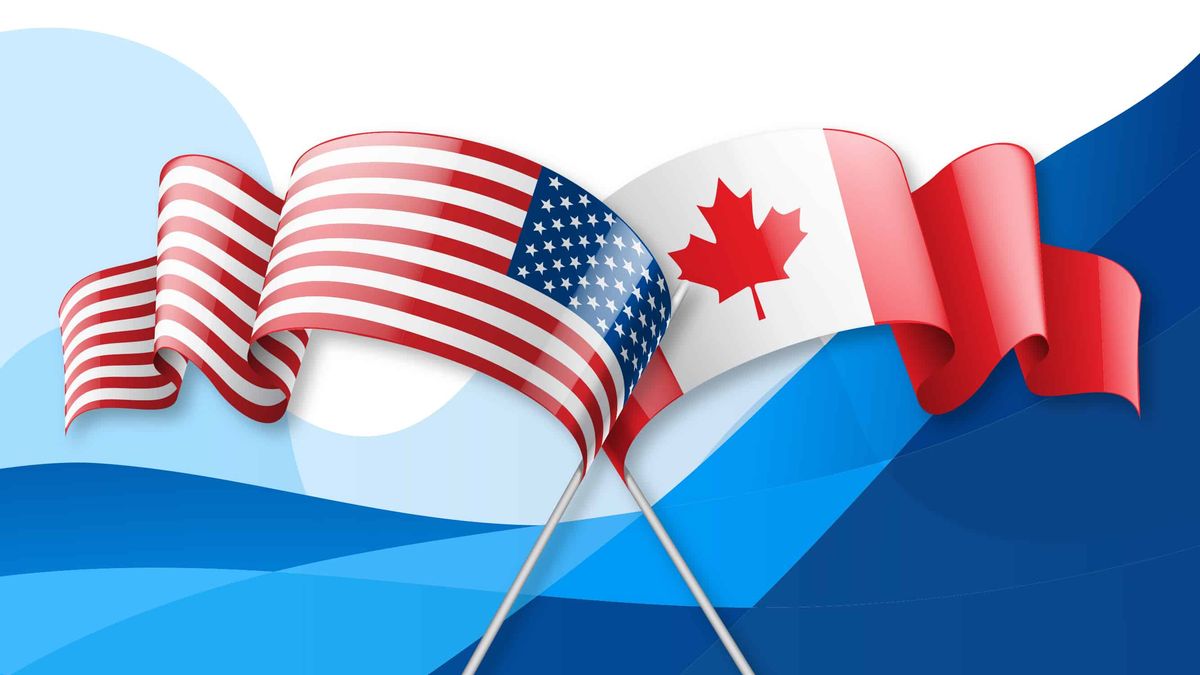Main Difference Between Selling on
Amazon.com vs Amazon.ca

If you’re a US Amazon seller, chances are you’ve probably thought about expanding into the neighboring Canadian market to grow your sales. Combined with its largely untapped market and the ease of selling cross-border from the same Amazon account, expansion to Amazon Canada can be one of the best business decisions you ever make.
Pricing Strategy
You may have thought pricing for Amazon.ca simply means converting your current prices into CAD. By all means you can do that, however, know that you can and should charge a higher price when selling on Amazon Canada. This is mostly due to the fact that Canadian consumers expect tax to be included in the price. Learn more about GST when expanding to Canada here. Let’s deep-dive into a set of examples to give you a clear understanding on different pricing strategies.

With Rapid Egg cooker by Dash, note that the same items are listed in separate marketplaces. At first glance, the difference in price is alarming. However, once you calculate the conversion from CAD to USD, you’ll see that the egg cooker in Canada actually costs roughly $29 USD. While not as alarming as before, it’s still a sizable difference.

EXAMPLE 2
In this example, we compare Orblue 4 in 1 camping utensils—specifically the 7.5’’ multifunctional knife 2-pack, their most popular variation.
Once again, it’s the same brand posting their listing in separate marketplaces. However, in this example, the prices are very similar.

Most sellers moving to Canada take advantage of the ability to increase their prices. It would seem that Orblue is either not aware of this (highly unlikely) or has intentionally made it part of their strategy.
EXAMPLE 3
As you can see, this seller has taken full advantage of the pricing discrepancy, unlike Orblue. This just goes to show the variety of approaches you can take on pricing strategy alone.

EXAMPLE 4
Lastly, we have the Boba baby wrap. Once again a single seller has listed the same product on both markets. One thing of note here is that this item is a little higher priced then the rest we’ve looked at so far. In this particular case, we have a pricing strategy aimed at achieving the same net profits in both markets.


As you can see, pricing strategies for Amazon.ca can vary widely. On one hand, higher prices and higher margins are more favorable for you. On the other hand, lower prices can give you a competitive edge and attract more shoppers.
Another thing to keep in mind is that the “profits” we had calculated for each example were just gross profits. We don’t know the actual cost of the product and the shipping and fulfillment details.
We’re not taking into consideration that shipping into Canada FBA may cost more than shipping into US FBA or the various sales taxes unique to Canada. Also, some products may fall into different tax categories, costing sellers varying amounts. Alternatively, some sellers may not be taxed altogether because their sales volume has not met the tax threshold. All this to say that there’s plenty of room for you to formulate and test out your pricing strategy in consideration of costs like manufacturing, fulfillment, and taxes.
Sales Volume
Canada’s population size is roughly 10% of the United States’, leading some to expect their total Canadian sales to amount to at least 10% of their US sales. Other sellers claim that due to less competition, their sales are actually higher than 10% of US sales.
The best way to set sales expectations is to compare real numbers. We will examine the same three products from our pricing strategy examples and compare their sales on both Amazon.com and Amazon.ca:

As you can see, none of the examples come close to being 10% of monthly US sales. However, there may be a reason for that. All of these products are well established on Amazon US and due to the higher number of users, they’ve had a chance to establish much better organic rankings. We can confirm this by comparing the number of keywords they’ve managed to get indexed for.

There is definitely a difference in keyword indexing between the two markets. We can’t say with certainty the exact number of keywords or different searches for one market over the other. However, given its population size alone, we can reason the sheer search volume in the US drives more keyword association for various products. This alone isn’t directly correlated with sales, but we can say that the number of indexed keywords does heavily affect sales.
You can achieve organic rankings by doing precise PPC campaigns with keywords that you know are being searched for in a specific market. In the examples above, we can conclude that either these listings have not done the best job of getting indexed on Amazon.ca or there are simply not that many keywords to get indexed on.
The numbers aren’t exactly rosy for our three examples, But it may be due to extreme success in the US market failing to replicated in Canada. The story may be different for products that have had moderate success in the US.
PPC Advertising Costs
You may be pleasantly surprised to learn that PPC ads are more effective and less costly for Canada. The Canadian market is less saturated, meaning less competition and fewer bidders raising the price of advertising targets. Of course, the fact that there are fewer users on Amazon.ca also means that search volume is lower, and bids tend to be lower for keywords that have a lower search volume. Regardless, this is all theoretical until we take a look at the actual numbers. Let’s examine the monthly search volumes for the top keywords that describe each of our 3 chosen products and compare them across the markets. We’ll also cover the average bids for those keywords.
Starting with our egg cooker, it’s topmost relevant keyword is unsurprisingly “egg cooker.” Now, let’s see the monthly search volume and the suggested bids:

This is the first time we see the 10:1 population ratio reflected in the market. The monthly search volume in Canada is fairly close to 10% of the US’s monthly search volume. While the bids are not 10 times lower, they are still considerably less. The bids on the right side are in CAD, so the bids are not in the range of 1.09 USD to 1.30 USD, it’s more like C$0.83 to C$1. This is a sizable difference.
For the Orblue utensils, we will look at “camping utensils.”

In this case, the difference is much clearer. The fact that the search volume in the US is a little over 4 times bigger and the average price per click is higher proves the assumption correct. Once again, keep in mind that the prices per click on the right are in CAD, which makes the range C$0.89 – C$1.43. The price per click for a broad search is on par with the US price, but the other two match types are much lower.
Lastly, we compare the most relevant keyword for the Boba baby wrap, “baby sling”:

The difference in the monthly search volume is a bit more pronounced, just as the difference in the suggested bids with exception to the broad match type. But to compare the US broad click suggested bid of $3.66 to the $1.34 in Canada is a staggering difference.
In the case of these three advertising targets, we can confirm that PPC ads on Amazon.ca is more cost effective than on Amazon.com. Keep in mind that the most important indicator of success for your PPC efforts is your Advertising Cost of Sales or ACOS. This is a percentage relationship between your total ad spend and your total sales revenue per target or a campaign. If you have a higher selling price in Canada and a lower price per click, you stand to have a much healthier ACOS in Canada..
We can see that the sales numbers were not comparatively as impressive as we’d hoped. However, we only compared a few top-selling items on Amazon.com. Also keep in mind that even if the sales numbers are not as high, you stand to make more profit per unit you have access to much more cost-effective PPC ads. In order to make the best decision for your business, it’s important for you to research your particular niche and repeat the processes we’ve highlighted here. Additionally, if you’re worried about committing too much in order to sell in Canada, we can tell you that it’s not as bad as you may think.
If you’re shipping goods directly from your supplier to a Canadian FBA facility, you won’t have to pay any duties or taxes until your sales revenue reaches C$30,000. You have the opportunity to test the market with a few units in order to determine if it’s worth committing to in the long run. Of course, trying to take advantage of a new opportunity always carries risks. However, it should be clear that the risks are minimal and the opportunity is right there.
Conclusion
Selling on Amazon.ca is definitely not the same as selling on Amazon.com. There are many different variables that can affect your ability to succeed. The market is smaller but it is also more . Amazon is currently building more FBA facilities in Canada to facilitate growth and an increasing number of Canadians are doing their shopping on Amazon.
Difference Between
Selling on
Amazon.com vs Amazon.ca

If you’re a US Amazon seller, chances are you’ve probably thought about expanding into the neighboring Canadian market to grow your sales. Combined with its largely untapped market and the ease of selling cross-border from the same Amazon account, expansion to Amazon Canada can be one of the best business decisions you ever make.
Pricing Strategy
You may have thought pricing for Amazon.ca simply means converting your current prices into CAD. By all means you can do that, however, know that you can and should charge a higher price when selling on Amazon Canada. This is mostly due to the fact that Canadian consumers expect tax to be included in the price. Learn more about GST when expanding to Canada here. Let’s deep-dive into a set of examples to give you a clear understanding on different pricing strategies.

With Rapid Egg cooker by Dash, note that the same items are listed in separate marketplaces. At first glance, the difference in price is alarming. However, once you calculate the conversion from CAD to USD, you’ll see that the egg cooker in Canada actually costs roughly $29 USD. While not as alarming as before, it’s still a sizable difference.

EXAMPLE 2
In this example, we compare Orblue 4 in 1 camping utensils—specifically the 7.5’’ multifunctional knife 2-pack, their most popular variation.
Once again, it’s the same brand posting their listing in separate marketplaces. However, in this example, the prices are very similar.

Most sellers moving to Canada take advantage of the ability to increase their prices. It would seem that Orblue is either not aware of this (highly unlikely) or has intentionally made it part of their strategy.
EXAMPLE 3
As you can see, this seller has taken full advantage of the pricing discrepancy, unlike Orblue. This just goes to show the variety of approaches you can take on pricing strategy alone.

EXAMPLE 4
Lastly, we have the Boba baby wrap. Once again a single seller has listed the same product on both markets. One thing of note here is that this item is a little higher priced then the rest we’ve looked at so far. In this particular case, we have a pricing strategy aimed at achieving the same net profits in both markets.


As you can see, pricing strategies for Amazon.ca can vary widely. On one hand, higher prices and higher margins are more favorable for you. On the other hand, lower prices can give you a competitive edge and attract more shoppers.
Another thing to keep in mind is that the “profits” we had calculated for each example were just gross profits. We don’t know the actual cost of the product and the shipping and fulfillment details.
We’re not taking into consideration that shipping into Canada FBA may cost more than shipping into US FBA or the various sales taxes unique to Canada. Also, some products may fall into different tax categories, costing sellers varying amounts. Alternatively, some sellers may not be taxed altogether because their sales volume has not met the tax threshold. All this to say that there’s plenty of room for you to formulate and test out your pricing strategy in consideration of costs like manufacturing, fulfillment, and taxes.
Sales Volume
Canada’s population size is roughly 10% of the United States’, leading some to expect their total Canadian sales to amount to at least 10% of their US sales. Other sellers claim that due to less competition, their sales are actually higher than 10% of US sales.
The best way to set sales expectations is to compare real numbers. We will examine the same three products from our pricing strategy examples and compare their sales on both Amazon.com and Amazon.ca:

As you can see, none of the examples come close to being 10% of monthly US sales. However, there may be a reason for that. All of these products are well established on Amazon US and due to the higher number of users, they’ve had a chance to establish much better organic rankings. We can confirm this by comparing the number of keywords they’ve managed to get indexed for.

There is definitely a difference in keyword indexing between the two markets. We can’t say with certainty the exact number of keywords or different searches for one market over the other. However, given its population size alone, we can reason the sheer search volume in the US drives more keyword association for various products. This alone isn’t directly correlated with sales, but we can say that the number of indexed keywords does heavily affect sales.
You can achieve organic rankings by doing precise PPC campaigns with keywords that you know are being searched for in a specific market. In the examples above, we can conclude that either these listings have not done the best job of getting indexed on Amazon.ca or there are simply not that many keywords to get indexed on.
The numbers aren’t exactly rosy for our three examples, But it may be due to extreme success in the US market failing to replicated in Canada. The story may be different for products that have had moderate success in the US.
PPC Advertising Costs
You may be pleasantly surprised to learn that PPC ads are more effective and less costly for Canada. The Canadian market is less saturated, meaning less competition and fewer bidders raising the price of advertising targets. Of course, the fact that there are fewer users on Amazon.ca also means that search volume is lower, and bids tend to be lower for keywords that have a lower search volume. Regardless, this is all theoretical until we take a look at the actual numbers. Let’s examine the monthly search volumes for the top keywords that describe each of our 3 chosen products and compare them across the markets. We’ll also cover the average bids for those keywords.
Starting with our egg cooker, it’s topmost relevant keyword is unsurprisingly “egg cooker.” Now, let’s see the monthly search volume and the suggested bids:

This is the first time we see the 10:1 population ratio reflected in the market. The monthly search volume in Canada is fairly close to 10% of the US’s monthly search volume. While the bids are not 10 times lower, they are still considerably less. The bids on the right side are in CAD, so the bids are not in the range of 1.09 USD to 1.30 USD, it’s more like C$0.83 to C$1. This is a sizable difference.
For the Orblue utensils, we will look at “camping utensils.”

In this case, the difference is much clearer. The fact that the search volume in the US is a little over 4 times bigger and the average price per click is higher proves the assumption correct. Once again, keep in mind that the prices per click on the right are in CAD, which makes the range C$0.89 – C$1.43. The price per click for a broad search is on par with the US price, but the other two match types are much lower.
Lastly, we compare the most relevant keyword for the Boba baby wrap, “baby sling”:

The difference in the monthly search volume is a bit more pronounced, just as the difference in the suggested bids with exception to the broad match type. But to compare the US broad click suggested bid of $3.66 to the $1.34 in Canada is a staggering difference.
In the case of these three advertising targets, we can confirm that PPC ads on Amazon.ca is more cost effective than on Amazon.com. Keep in mind that the most important indicator of success for your PPC efforts is your Advertising Cost of Sales or ACOS. This is a percentage relationship between your total ad spend and your total sales revenue per target or a campaign. If you have a higher selling price in Canada and a lower price per click, you stand to have a much healthier ACOS in Canada..
We can see that the sales numbers were not comparatively as impressive as we’d hoped. However, we only compared a few top-selling items on Amazon.com. Also keep in mind that even if the sales numbers are not as high, you stand to make more profit per unit you have access to much more cost-effective PPC ads. In order to make the best decision for your business, it’s important for you to research your particular niche and repeat the processes we’ve highlighted here. Additionally, if you’re worried about committing too much in order to sell in Canada, we can tell you that it’s not as bad as you may think.
If you’re shipping goods directly from your supplier to a Canadian FBA facility, you won’t have to pay any duties or taxes until your sales revenue reaches C$30,000. You have the opportunity to test the market with a few units in order to determine if it’s worth committing to in the long run. Of course, trying to take advantage of a new opportunity always carries risks. However, it should be clear that the risks are minimal and the opportunity is right there.
Conclusion
Selling on Amazon.ca is definitely not the same as selling on Amazon.com. There are many different variables that can affect your ability to succeed. The market is smaller but it is also more . Amazon is currently building more FBA facilities in Canada to facilitate growth and an increasing number of Canadians are doing their shopping on Amazon.
Psst…More Amazon Guides where that came from. Always be updated with the latest tips!










